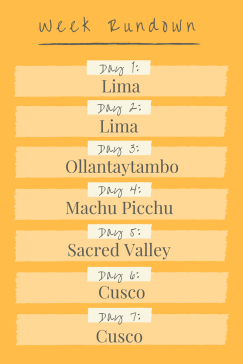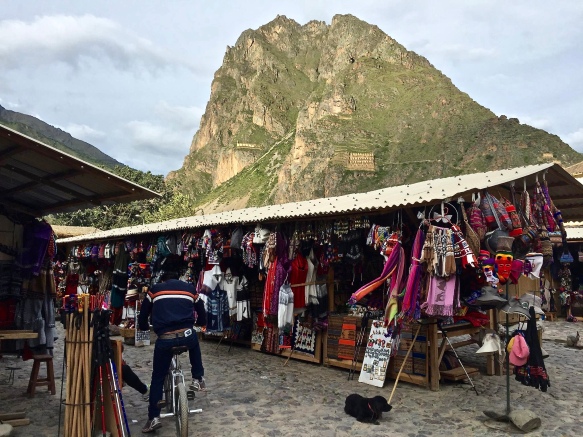– The Gist –
Peru is best known for Machu Picchu, but the country has so much more to offer. For a one-week trip, focus your time on Lima and around Cusco. If you have more time, try visiting Lake Titicaca, which is on the border with Bolivia and is known for the floating islands of reeds that drift on the Peruvian side of the lake; or if you’re more adventurous, partaking in the four-day trek to Machu Picchu.


– Lima –
As with most large cities, Lima is divided into districts, and each comes with its own personality and characteristics. The many markets give the city flavor and haggling is a common practice. A city must, ceviche and pisco sours. Anywhere and everywhere.
We stayed at Hostal El Patio in Miraflores which is arguably the chicest neighborhood in Lima. In Miraflores is Larcomar, a large outdoor shopping mall with shops you would normally see in the U.S. The unique part about this mall is that it is on the edge of a cliff, overlooking a direct drop into the ocean. Along the coastline, the city has similar extremes with long slanted sidewalks and staircases to travel up and down the many hills.


– Road to Machu Picchu –
There is more than one way to reach Machu Picchu, including hiking, bus, train, and driving. We chose the train as it was the simplest and most time-effective. Get PeruRail tickets well in advance as this option is popular. From Lima, you can fly to Cusco within an hour and a half. Those wishing to visit Machu Picchu the next day have three primary options for the night: stay in Cusco, stay in Ollantaytambo, or stay in Aguas Calientes. A few hours north of Cusco, Aguas Calientes is the nearest town to Machu Picchu. However, due to luggage restrictions on the train, we chose Ollantaytambo, a small town along the train route between Cusco and Aguas Calientes, as our base point.

Wherever you choose to stay, you will journey to Aguas Calientes and immediately follow the hoard of tourists to the bus station for the 15 minute bus ride up the mountain and to the entrance of Machu Picchu. At the entrance, there are guides all around, offering their tour services. We looked for one with a clearly marked vest, knowing she was with a company, and it was well-worth the purchase as she was able to explain the history and meaning of the various stone structures, which admittedly, begin to all look very similar after an hour in the vast city.
In the picture below, you will see Machu Picchu’s detailed architectural structures, and Huayna Picchu is the tall peak just beyond. In order to climb Huayna Picchu, you need an extra ticket, and there is a daily limit. Locals brag that they can climb to the top in 25 minutes, which I don’t doubt, just can’t match. We took about an hour and that was with much griping on my end. I would scare you with the amount of stairs you will have to master, but the view was worth every single step.

– Ollantaytambo and Aguas Calientes –
Ollantaytambo was the perfect point to stay at for our journey to Machu Picchu. The town was a nice stroll with a small central plaza. Here, you can venture a taste at alpaca (a lot like steak). Our hotel, El Albergue, had a phenomenal restaurant with the meals prepared with ingredients from its organic farm just out back and homemade pasta you can see hanging from the open kitchen throughout the day. As soon as you walk out of the door, you’re at the train station…a convenient fact when you are catching the 5 a.m. train to Aguas Calientes. They also have an option to pack breakfast and lunch for you, which will help hold you over on your long, long day.
Similarly, Aguas Calientes is worth a walk around. Everyone comes for Machu Picchu, but set aside an hour in the evening to wander the city’s market and riverfront. This is also a good idea so you don’t miss the last train out of town! For those who prefer to stay the night next to Machu Picchu, travelers will hold their luggage at a hotel in Cusco and just pack a night bag that’s small enough to take on the train. That way, you can be first at the Lost City’s gates in the morning and make the most of a one-day ticket.

– Cusco –
Cusco is a much more manageable size than sprawling Lima and lends itself as shopping town, especially for baby alpaca garb. We stayed at El Balcon, a sister property to El Albergue in Ollantaytambo, which helped us hitch a ride between the two cities with our luggage. The city has what is by now a trend of hilly streets and winding cobblestone roads. As you will surely shop in the city, remember that souvenirs can be found for cheaper when traveling through the Sacred Valley and prices in shops where items do not have price tags are negotiable.
A personal recommendation is to stop by the Pisco Museum (Museo del Pisco). More bar than museum, the bartenders explain the history of pisco, and why they insist it’s Peruvian, not Chilean, as they pour you various makes of the liquor.


– Pro Tips-
- Ask your hotels about transportation from the airport. Typically, they can set you up with a driver and can tell you how much it will cost in advance. You often pay the driver directly, but be sure to clarify this fact with the hotel before you go.
- Altitude sickness is real! Drink lots of water, avoid too much alcohol, and get medication in advance from your doctor if going to Cusco. Another trick, spending a day or two in Aguas Calientes or Ollantaytambo, which are slightly lower altitudes (but still high up), can help your body adjust to the 11,152′ altitude of Cusco.
- Easy on the ice. It’s recommended to use bottled water for everything as Americans’ stomachs aren’t used to the Peruvian water. Often forgotten: washed fresh fruits/veggies and ice in your drink.
- If possible, negotiate prices in Spanish. This tip came from Peruvians I spoke to prior to my trip. They said, even if the vendor knows you are not a native Spanish speaker, it still gets you a better deal than the “gringo prices.”

You must be logged in to post a comment.